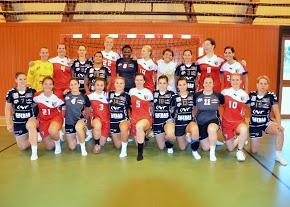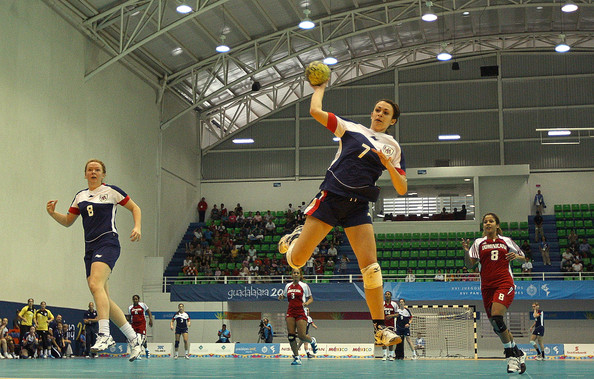
Stephanie Hesser: The leading scorer for Team USA and one of the few bright spots for the team.
Overall Results
The 2011 Women’s Pan American Championships concluded this past weekend with fairly predictable results. Brazil dominated the completion winning all 6 of their games by an eye popping average of 30 goals. The Dominican Republic came the closest, losing by only 15 in group play. The runners up, Argentina, lost by 23 in the Gold Medal, but can take some consolation in their 10 goal victory over the Dominican Republic in the semifinals. That clear victory establishes that side as the 2nd best team in Pan America. With Brazil already qualified as the 2016 Olympics host, Argentina should be favored to take 2nd place at the 2015 PANAM Games in Canada, where the Pan American slot for the 2016 Olympics will be awarded.
In terms of 2013 World Championships qualification, Paraguay was the surprise team joining Brazil, Argentina and the Dominican Republic as the 4 representatives from Pan America. This is the 2nd time Paraguay has pulled off a surprise as they also qualified in 2007.
Pan American Championships Results Page: Link
U.S. Results

The U.S. came away with a 1-5 record and took 8th place out of 10 teams. Against their top opponents in pool play lost to Brazil, 44-10 and the Dominican Republic, 27-11. Against the 3 teams that placed 5th (Uruguay), 6th (Mexico) and 7th (Venezuela) the U.S. lost by 13, 7 and 7 goals respectively, with the bright spot being that each of those matches were closely contested until those opponents pulled away in the 2nd half. On the positive side, the U.S. did have a convincing 17 goal victory over Costa Rica, but this is tempered by the fact that the Central American debutantes lost all 5 of their matches by an average of 26 goals.
Individually, Stephanie Hesser, was the stand out player for the U.S. leading the team in scoring with 27 goals. At 19 years of age, she was also the team’s youngest court player, so one can hope that she will continue to improve as a player for many years to come. After Hesser, the U.S. had 5 other players with at least 10 goals in the 6 matches. Those players are Megan Ballard (16), Julia Taylor (15), Kathy Darling (14), Tomuke Ebuwei (12) and Sarah Gascon (10). Federation reports on the matches also indicate decent performances in the goal by Sophie Fasold and Freja Dobreff.
Video of several of the matches is available on the Pan American Team Handball Federation YouTube channel. Although, the video is not of the best quality a sampling of several matches highlights some glaring weaknesses with the U.S. In particular, the U.S. offensive attack lacks quickness and the team does not have any backcourt players with significant 1 on 1 scoring capability. This lack of a scoring punch is most evident in the total goals scored against Brazil (10) and the Dominican Republic (11). Defensively, the team does fairly well when it gets a chance to get set up, but offensive turnovers resulted in far too many fast breaks. Finally, the 2nd half collapses against weaker foes, Uruguay, Mexico, Venezuela points to a lack of conditioning playing a role at the end of matches.
A Sideways Trend
Unfortunately, these poor results are nothing new for the USA Women. Here’s a review of how the team has placed in Pan American competitions since 2007:
2007 Pan American Championships: 7th out of 8 teams
2007 Pan American Games: Did not qualify
2009 Pan American Championships: Did not qualify
2011 Pan American Championships: Did not qualify
2011 Pan American games: 8th out of 8 teams
2013 Pan American Championships 8th out of 10 teams
(Note: The Pan American Championship is held every 2 years and the top 3-4 teams qualify for the World Championships. The Pan American Games are held every 4 years and the top team qualifies for the Olympics)
And here’s a comparison of 2010/11 and 2013 match results against the same nations:
vs Brazil (2011): Loss 50-10 (pool play)
vs Brazil (2013): Loss 44-10 (pool play)
vs Dominican Republic (2011): Loss 33-26 (pool play)
vs Dominican Republic (2013): Loss 27-11 (pool play)
vs Mexico (2011): Loss 29-27 (consolation semi)
vs Mexico (2013): Loss 30-23 (pool play)
vs Uruguay (2011): Loss 36-24 (pool play)
vs Uruguay (2011): Loss 30-23 (7th place match)
vs Uruguay (2013): Loss 30-17 (consolation semi)
vs Venezuela (2010): Loss 32-21 (PANAM Games Qualifier)
vs Venezuela (2013): Loss 36-29 (7th place match)
Chances for 2016 Qualification
Looking at that these numbers it’s hard to rationalize a dramatic upward trajectory that leads to qualifying for the 2016 Olympics. Perhaps, if Team USA had been able to muster a semifinal berth or even a 5th place showing a decent case could be made that the team was on the verge of a breakthrough. Instead, against the best sides it’s pretty evident that the U.S. is totally outclassed. And, even against other developing nations, there’s a significant gap as the U.S. has been consistently on the losing side, albeit by smaller margins. Yes, the U.S. was missing its leading scorer from the 2011 PANAM Games, Karoline Borg, but while she is a skilled player who would have helped steady the team I would assess her presence would simply resulted in some slightly more respectable score lines.
So, can the U.S. close the gap? And more importantly, can it do so by July 2015 when the PANAM Games take place in Toronto, Canada? Well, anything is possible. But, as I pointed out previously a number of things would have to fall into place. First and foremost, the player pool of talented athletes needs to expand dramatically and quickly. And, if those athletes can be found quickly they would need a highly structured training environment supplemented with regular competition. Can the players be found that quickly? Does USA Team Handball have the funds or USOC support to set up a full-fledged (not an austere) Residency Program? I don’t think the answers to either of those questions are “yes” and quite frankly, even if they were, two years is not a lot of time to work with.
Time to throw in the towel?
I most adamantly would never advocate telling an athlete to give up the fight in the heat of a competition. And, I also would be reluctant to even diplomatically give such advice to an athlete that’s pondering their future. I’ve been there and such a decision is a personal one dependent on a number of variables. It’s not always a rationale or logical choice and it’s up to each individual to make that decision.
For organizations, however, decisions on the future should be made carefully, rationally, logically and firmly based on that organization’s goals. And while it’s rarely a popular decision, throwing in the towel is sometimes the right decision. Especially, if it’s not really giving up, but merely redirecting resources towards future success.
With those thoughts in mind, it should be clear that USA Team Handball should be developing a plan which is more focused on 2020 or even 2024 Olympic Qualification. This means spending funds and man-hours on efforts that will that maximize the likelihood that younger and more talented athletes are found and developed. In other words, athletes that just might be around 7 or even 11 years from now. If one looks at the U.S. roster from the last event there are only 4 athletes that definitely fit that criterion: Stephanie Hesser, Julia Taylor, Sophie Fasold and Freja Dobreff.
Youth isn’t everything, but it’s well known that every sports franchise takes an athlete’s current age into consideration before it signs a long term contract. Older players can and do win (How about my San Antonio Spurs), but unless they are at the top of their game younger players will come along to gently ease them into retirement. Not simply because they are younger, but because they are better.
I’ll close with one last telling statistic that should give any doubters further pause. Argentina, which is clearly the team that the U.S. and any other wannabe Pan-American team has to beat for Rio, fielded a squad with an average age of 22.9 years. Only 3 players on the U.S. roster were younger than average.
























